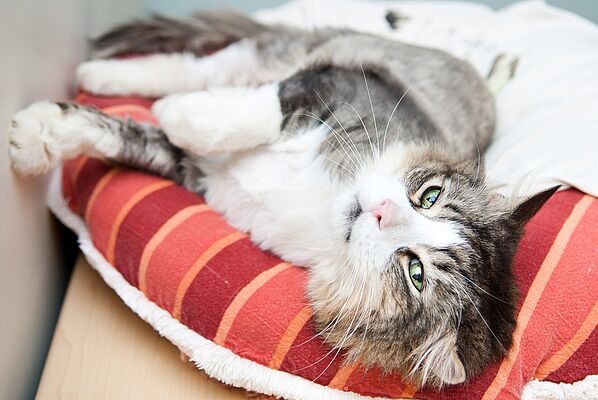Cats spend about one-third of their waking hours grooming themselves.
There is additional grooming you should do. Grooming is a great opportunity to bond with your cat while providing him with the care he needs.
Self-Grooming
Cats always groom in the same sequence:
- Lick their lips
- Lick the side of one paw until it is wet
- Rub the wet paw over the head, including the ear, eye, cheek and chin
- Wet the other paw in the same way
- Rub the other paw over the other side of the head.
- Clean (by licking) the front legs and shoulders
- Clean flanks
- Clean genitals
- Clean hind legs
- Clean the tail from base to tip
Trimming Nails
Trim your cat's nails as needed (every one to four weeks). This reduces the likelihood of damage caused by sharp claws and lessens the possibility of the nail growing into the pad and causing infection.
To start, first get your cat used to having his paws handled. Sit with him in a quiet space away from other animals and distractions. Give him a treat as you touch his paw. As he gets used to this, start to gently press one toe at a time to expose the claw. If your cat seems stressed or tries to get away, stop and resume petting without touching his feet.
Once your cat is comfortable with you holding and touching his paws, you are ready to trim a nail. Use sharp trimmers specifically designed for pets. Cats do best with scissor-type trimmers. Start at the tip of the nail and snip a little. If your cat seems stressed or tries to get away, take a break and try again later.
Avoid cutting into the quick, which looks pink under white nails. It contains nerves and blood vessels and is painful and will bleed easily if cut. If the tip of the nail begins to bleed, apply pressure using styptic powder or a substitute such as baby powder, flour or cotton. Do not wipe the blood clot off the tip of the nail once the bleeding has stopped.
Don’t attempt to trim more than one or two nails at a sitting until your cat shows he is comfortable with nail trimming.
Brushing
Be sure to brush your cat’s coat at least once a week to keep it shiny, sleek and clean.
Brushing is also a great time to check for fleas and flea dirt—those little black specks that indicate your pet is playing host to a flea family.
Different brushes and techniques are used for different coat lengths. Check with your vet to see what type of brush you should use, how often you should brush and what process you should use.
Dental Hygiene
Home dental care is the first line of defense against periodontal disease in cats. The biggest weapon is the toothbrush.
Ideally, you can brush your cat’s teeth once a day, but please do so at least three to five times a week. Use a soft bristled toothbrush and veterinary-approved cat formula toothpaste. Make brushing your cat’s teeth a positive experience. First, get him used to you handling him around his mouth. When touching the mouth, put a tasty treat on your finger to make the experience positive for your pet. Once he is comfortable with this, begin rubbing the gums. Then gradually increase the time you spend playing with the mouth.
Additional tools to help prevent dental disease include gels and rinses that are rubbed on the gums. There are also diets formulated to help reduce plaque. Ideally these should be used along with brushing your cat’s teeth, not in place of.

